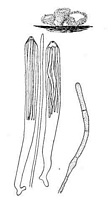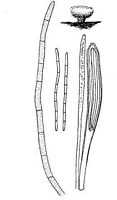|
 Lachnum abnorme Lachnum abnorme
SynonymsDasyscyphus cassandrae
Dasyscyphus corticola
Peziza abnormis
BiostatusPresent in region - Indigenous. Non endemic
Images (click to enlarge)
Caption: Fig. 5. Dasyscyphus cassandrae. Habit sketch x 10, details x 660. | 
Caption: Fig. 6 Dasyscyphus corticola. Habit sketch x 10, details x 660. |
Article: Dennis, R.W.G. (1961). Some inoperculate Discomycetes from New Zealand. Kew Bulletin 15(2): 293-320.
Notes: The material is rather poorly preserved with the hymenia largely destroyed by insects and
ascospores have not been seen free from the asci so it is not certain if they ultimately become
septate. The identification is based on Tranzschel's diagnosis only as no authentic material of
D. cassandrae has been seen. The type was on dead twigs of Cassandra calycantha Don
(Ericaceae) from European Russia. A collection (G. H. Cunningham 18979) on Rhopalostylis
sapida (Palmae) from Whangarei, Parahaki reserve, seems scarcely distinct in spite of the very
different substrate.
Article: Dennis, R.W.G. (1961). Some inoperculate Discomycetes from New Zealand. Kew Bulletin 15(2): 293-320.
Description: Apothecia scattered, superficial, with short stout stalks; disc up to 2 mm. diameter, almost flat
when fresh, with a low rim, deep yellow; receptacle pallid, clothed with fine light brown hairs,
flesh compact, white. Hairs cylindrical, undulating, obtuse, up to 160 x 3.5-4 µ, with thin,
brown, finely granulate walls and numerous septa. Asci cylindric-clavate, 100- 115 x 8-9 µ, 8-spored,
apex conical, with a minute pore blued by Melzer's reagent; ascospores fasciculate,
cylindrical, 7-septate, 54-62 x 1.5-2 µ; paraphyses slightly enlarged upwards to 3 µ, scarcely
longer than the asci and not acutely pointed.
Notes: Dasyscyphella schroeteriana Rehm (1900) from Brasil, seems doubtfully distinct. Peziza
leucophaea Berk. & Curt. (1860), on sticks in Japan, is similar but paler and with slightly
longer ascospores, 60-70 x 1.5 µ. D. corticola must not be confused with the common
European D. corticalis (Pers. ex Fr.) Massee, which has 1-septate ascospores 10-20 x 2-3.5 µ.
|